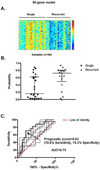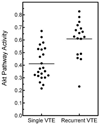Whole blood gene expression analyses in patients with single versus recurrent venous thromboembolism
- PMID: 21737128
- PMCID: PMC3726737
- DOI: 10.1016/j.thromres.2011.06.003
Whole blood gene expression analyses in patients with single versus recurrent venous thromboembolism
Abstract
Introduction: Venous thromboembolism may recur in up to 30% of patients with a spontaneous venous thromboembolism after a standard course of anticoagulation. Identification of patients at risk for recurrent venous thromboembolism would facilitate decisions concerning the duration of anticoagulant therapy.
Objectives: In this exploratory study, we investigated whether whole blood gene expression data could distinguish subjects with single venous thromboembolism from subjects with recurrent venous thromboembolism.
Methods: 40 adults with venous thromboembolism (23 with single event and 17 with recurrent events) on warfarin were recruited. Individuals with antiphospholipid syndrome or cancer were excluded. Plasma and serum samples were collected for biomarker testing, and PAXgene tubes were used to collect whole blood RNA samples.
Results: D-dimer levels were significantly higher in patients with recurrent venous thromboembolism, but P-selectin and thrombin-antithrombin complex levels were similar in the two groups. Comparison of gene expression data from the two groups provided us with a 50 gene probe model that distinguished these two groups with good receiver operating curve characteristics (AUC 0.75). This model includes genes involved in mRNA splicing and platelet aggregation. Pathway analysis between subjects with single and recurrent venous thromboembolism revealed that the Akt pathway was up-regulated in the recurrent venous thromboembolism group compared to the single venous thromboembolism group.
Conclusions: In this exploratory study, gene expression profiles of whole blood appear to be a useful strategy to distinguish subjects with single venous thromboembolism from those with recurrent venous thromboembolism. Prospective studies with additional patients are needed to validate these results.
Copyright © 2011 Elsevier Ltd. All rights reserved.
Conflict of interest statement
None of the authors have any conflicts of interest to declare.
Figures


References
-
- Beckman MG, Hooper WC, Critchley SE, Ortel TL. Venous thromboembolism: a public health concern. Am J Prev Med. 2010;38:S495–S501. - PubMed
-
- Heit JA, Mohr DN, Silverstein MD, Petterson TM, O'Fallon WM, Melton LJ., III Predictors of Recurrence After Deep Vein Thrombosis and Pulmonary Embolism: A Population-Based Cohort Study. Arch Intern Med. 2000;160:761–768. - PubMed
-
- Lopez JA, Kearon C, Lee AY. Deep venous thrombosis. Hematology Am Soc Hematol Educ Program. 2004:439–456. - PubMed
-
- Bauer KA. The thrombophilias: well-defined risk factors with uncertain therapeutic implications. Ann Intern Med. 2001;135:367–373. - PubMed
-
- Lindhoff-Last E, Luxembourg B. Evidence-based indications for thrombophilia screening. Vasa. 2008;37:19–30. - PubMed
Publication types
MeSH terms
Substances
Grants and funding
LinkOut - more resources
Full Text Sources
Medical
Molecular Biology Databases

